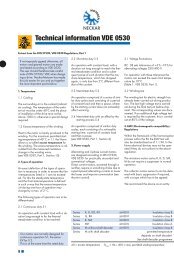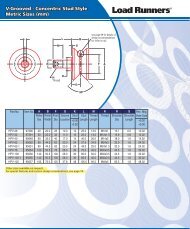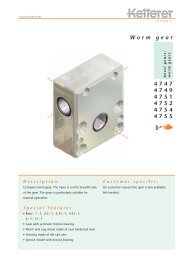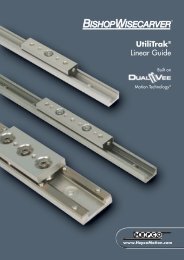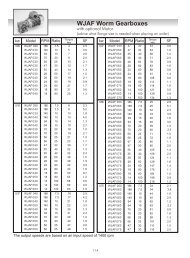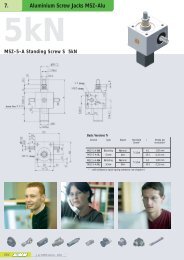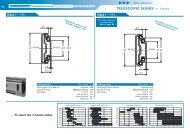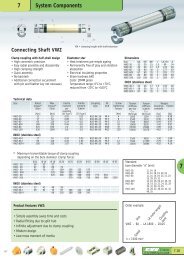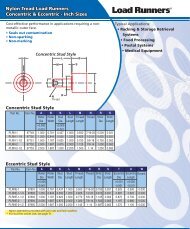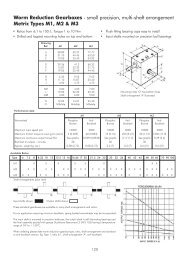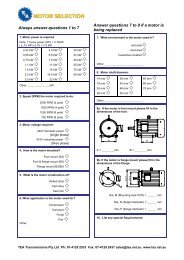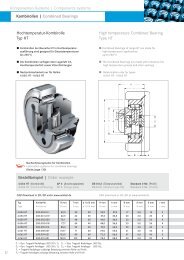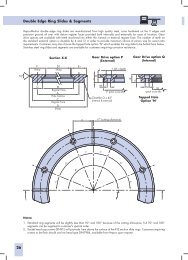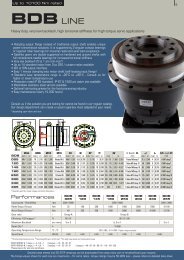Motors - TEA Machine Components Inc.
Motors - TEA Machine Components Inc.
Motors - TEA Machine Components Inc.
You also want an ePaper? Increase the reach of your titles
YUMPU automatically turns print PDFs into web optimized ePapers that Google loves.
MOTOREN<br />
NECKAR<br />
Technology<br />
Brushless Direct current <strong>Motors</strong><br />
The series M and MH electronically commutated<br />
direct current motors are of similar<br />
construction to induction motors. The 12-<br />
slot stator is equipped with a 4-pole winding.<br />
Adjustment of the winding to the voltage<br />
and operating conditions is possible.<br />
In comparison to the induction motor a rotor<br />
is used here with high-quality Neodymium<br />
magnets instead of the “simple” squirrel-cage.<br />
Rotor position detection is integrated in the<br />
motor. This consists of a magnetic disk rotating<br />
with the rotor and three Hall sensors<br />
arranged at 120°.<br />
The signals from the rotor position detection<br />
are evaluated by the control electronics<br />
required for operation. According to<br />
the position of the rotor the winding<br />
strands are streamed according to the following<br />
control scheme.<br />
Properties:<br />
The series M electronically commutated<br />
direct current motors are characterised by<br />
extreme reversing and acceleration properties.<br />
Series M is to some degree<br />
replaceable with other current types of<br />
similar size.<br />
While the service life of mechanically<br />
commutated direct current motors depends<br />
on that of the brushes, lying at approx.<br />
3,000–5,000 hours, the service life of an<br />
electronically commutated direct current<br />
motor only depends on the service life expectancy<br />
of the ball bearings, lying at<br />
over 20,000, presuming professional installation.<br />
The electronically commutated<br />
motor combines the known advantages of<br />
the 3-phase motor and the special features<br />
of the MH-motor in an almost exemplary<br />
fashion.<br />
The connection between speed, number of poles and number of slots on the stator can<br />
be seen in the following table.<br />
Rated speed No. of poles No. of slots<br />
3000 min –1 4 12<br />
750 min –1 8 24<br />
Standard control scheme<br />
left-hand rotation right-hand rotation<br />
Control scheme<br />
1 Revolution<br />
Besonderheiten des MH-<strong>Motors</strong><br />
As already mentiones, external control<br />
electronics are required for operation of<br />
the M-motors. With the development of<br />
integrated electronics we have been able<br />
to integrate a complete 1-Q-Controller into<br />
the motor. A lot of new ideas had to be<br />
used for this. The advantages of this solution<br />
are numerous:<br />
Sensor 1<br />
Sensor 2<br />
Sensor 3<br />
Commutation<br />
phase<br />
Motor phase A<br />
Motor phase B<br />
Motor phase C<br />
Motor phase A<br />
Motor phase B<br />
Motor phase C<br />
– The sensitive rotor position detection<br />
leads do not have to be led out anymore.<br />
– Damage caused by rotor position detector<br />
wiring faults can not occur.<br />
– The control of complex machines is<br />
simplified.<br />
– Continuous power as with motors with<br />
external electronics<br />
– Control range 30:1<br />
– Rotation reversal, fault signal output,<br />
impulse output (all SPS (Stored programme<br />
controller) level), short circuit<br />
braking and smooth starting with terminal<br />
box K4 integrated as standard.<br />
– Optional plug-and-socket connection.<br />
– “Stand-Alone-Operation“ possible.<br />
22 ■



